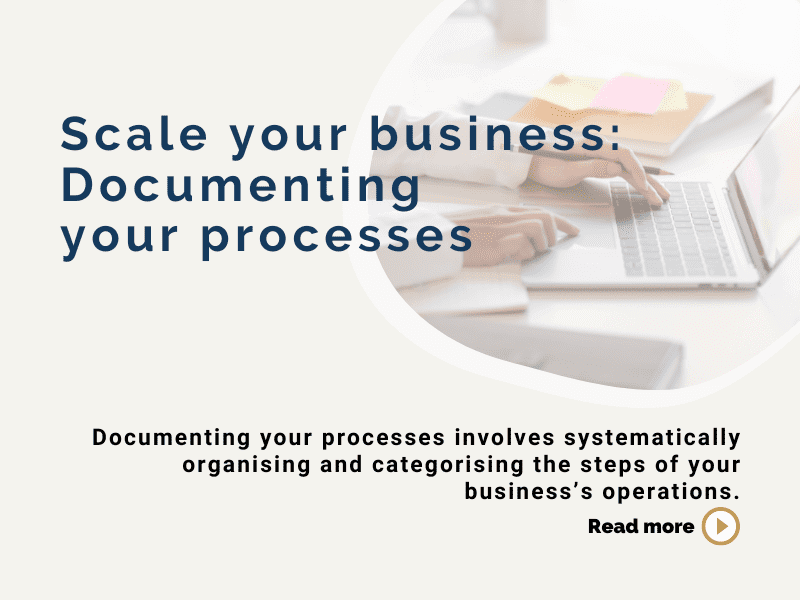Hands up if you enjoy travelling? Sightseeing and immersing yourself in a new culture, meeting new people, trying new things … It’s exciting isn’t it?!
But you would leave home without your bag though, would you?
Well, documenting your processes is like packing for a holiday.
Just as a traveller carefully organises their belongings into a suitcase, documenting your processes involves systematically organising and categorising the steps of your business’s operations.
Without proper documentation, it’s like going on a trip without a packed bag – you might forget essential items or encounter unnecessary delays, or need to make a detour.
But with well-documented processes in your business, you’re equipped with everything you need to navigate smoothly through your business journey, ensuring efficiency, clarity, and success along the way.
So in this blog, we are going to pack your business bag and go on a trip to improve your business.
Why document your processes?
It’s about decluttering and organising to make everything run smoother.
Documenting your processes also helps share know-how among your team, making it easy for everyone to follow the same pages of the same book.
It’s helpful for training new recruits and contractors because it gives them a clear roadmap to onboard them faster.
And don’t forget, having everything written down shines a light on areas that could use improving, helping you tweak and refine as you go.
Let’s look at a real-life example for that last point, growing your team.
Business story: How my client grew their team
One of my clients was growing rapidly and they needed to expand their team, which is great news. They wanted to promote the current marketing VA, Sue, to marketing coordinator and then find another marketing VA to fill Sue’s former role.
But before they could start recruiting to hire a new team member, Sue will need to develop work instructions or SOPs (standard operating procedures) so there is a smooth transition when the new team member comes onboard.
Sue had some procedures in place when she first started but some of the information is now outdated and hasn’t been updated to the latest practices.
Here is how Sue and I worked together on this mammoth task
- Interviewed Sue on her current role and responsibilities.
- Reviewed the SOPs she has already developed to update them.
- Made a list of her responsibilities and helped her to prioritise which process documentation to start, and work out whether to develop a new process or improve the existing one.
- Created a new file/document for each task.
- Used various methods to document procedures including checklists, tutorials, forms, videos, mind map, and screenshots.
- Once completed, I reviewed the SOPs again to make sure Sue clearly identified all resources and documents associated with the task, finding the missing gaps so the new team member is able to work independently as much as possible and reduce the bottlenecks in the operations.
- Test the procedure to validate the workflow to make sure the process is clear and effective – and it works.
- Handover the procedure to the new team.
- Measure the effectiveness of the procedure based on the new team member’s performance. They should be able to perform the task independently and accurately according to the SOP.
- Encourage the new marketing VA to continuously review and refine the procedures based on outcome and feedback to optimise efficiency and effectiveness in marketing tasks.
Where to next after documenting your processes?
Once you are finished documenting your processes, the next step is to implement and integrate them into action.
Implementation often includes training employees on the new processes, integrating them into daily workflows, and monitoring their effectiveness.
Additionally, you will need to continuously review and keep updating and documenting your processes to ensure they remain relevant and aligned with evolving needs and goals.
Regular evaluation and optimisation are also crucial to identify areas for improvement and maximise the benefits of your documented processes for long-term success.
Get this SOP Template and start documenting your processes today
SOPs (standard operating procedures) are essential in your business because they become your clear guidelines and instructions for all tasks.
This saves you having to remember everything in your head and tell your team how to perform their tasks.
They also establish consistency in operations, help to reduce errors, can be used to train new employees, and ensure compliance with industry regulations.
SOPs help with continuous improvement by providing a baseline to evaluate and refine your processes over time.
Get your SOPs up to date with this new template
If you are ready to streamline your business operations and boost efficiency, then my new, very easy to use, free SOP Template is for you.
The SOP Template is a quick reference guide so you know what to write when documenting your processes.
Get your SOP Template today and start simplifying your business operations.






